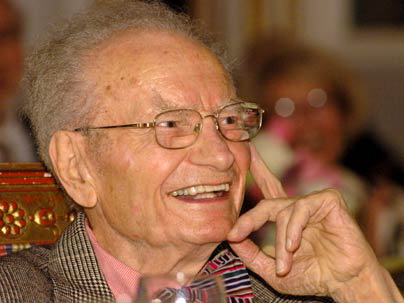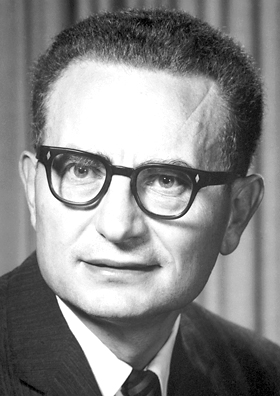<Back to Index>
- Economist Paul Anthony Samuelson, 1915
- Writer Arthur Schnitzler, 1862
- Prime Minister of the Netherlands Floris Adriaan van Hall, 1791
PAGE SPONSOR
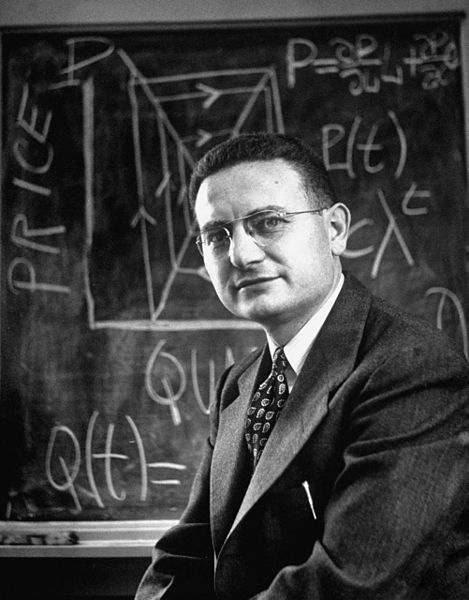
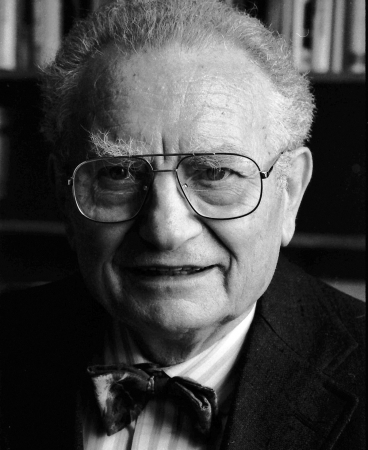
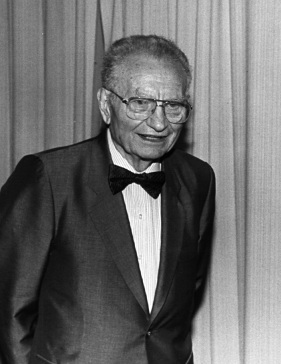
Paul Anthony Samuelson (May 15, 1915 – December 13, 2009) was an American economist, and the first American to win the Nobel Memorial Prize in Economic Sciences. The Swedish Royal Academies stated, when awarding the prize, that he "has done more than any other contemporary economist to raise the level of scientific analysis in economic theory." Economic historian Randall E. Parker calls him the "Father of Modern Economics", and The New York Times considered him to be the "foremost academic economist of the 20th century."
He was author of the largest selling economics textbook of all time: Economics: An Introductory Analysis, first published in 1948. It was the second American textbook to explain the principles of Keynesian economics and how to think about economics, and the first one to be successful, and is now in its 19th edition, having sold nearly 4 million copies in 40 languages. James Poterba, former head of MIT's Department of Economics, noted that by his book, Samuelson "leaves an immense legacy, as a researcher and a teacher, as one of the giants on whose shoulders every contemporary economist stands." In 1996, when he was awarded the National Medal of Science, considered America's top science honor, President Bill Clinton commended Samuelson for his "fundamental contributions to economic science" for over 60 years.
He entered the University of Chicago at age 16, during the depths of the Great Depression, and received his PhD in economics from Harvard. After graduating, he became an assistant professor of economics at Massachusetts Institute of Technology (MIT) when he was 25 years of age and a full professor at age 32. In 1966, he was named Institute Professor, MIT's highest faculty honor. He spent his career at MIT where he was instrumental in turning its Department of Economics into a world - renowned institution by attracting other noted economists to join the faculty, including Robert M. Solow, Paul Krugman, Franco Modigliani, Robert C. Merton and Joseph E. Stiglitz, all of whom went on to win Nobel Prizes. Samuelson was instrumental in the initial development of Indian Institute of Management Calcutta, the first Indian Institute of Management.
He served as an advisor to Presidents John F. Kennedy and Lyndon B. Johnson, and was a consultant to the United States Treasury, the Bureau of the Budget and the President's Council of Economic Advisers. Samuelson wrote a weekly column for Newsweek magazine along with Chicago School economist Milton Friedman, where they represented opposing sides: Samuelson took the Keynesian perspective, and Friedman represented the Monetarist perspective. Samuelson died on December 13, 2009, at the age of 94.
Samuelson was born in Gary, Indiana, on May 15, 1915, to Frank Samuelson, a pharmacist, and the former Ella Lipton. His family, he said, was “made up of upwardly mobile Jewish immigrants from Poland who had prospered considerably in World War I, because Gary was a brand new steel town when my family went there.” In 1923 Samuelson moved to Chicago; he studied at the University of Chicago and received his Bachelor of Arts degree there in 1935. He then completed his Master of Arts degree in 1936, and his Doctor of Philosophy in 1941 at Harvard University. As a graduate student at Harvard, Samuelson studied economics under Joseph Schumpeter, Wassily Leontief, Gottfried Haberler, and the "American Keynes" Alvin Hansen. Samuelson comes from a family of well - known economists, including brother Robert Summers, sister - in - law Anita Summers, and nephew Larry Summers.
During his seven decades as an economist, Samuelson's professional positions included:
- Assistant Professor of Economics at M.I.T, 1940, Associate Professor, 1944.
- Member of the Radiation Laboratory 1944 - 1945.
- Professor of International Economic Relations (part - time) at the Fletcher School of Law and Diplomacy in 1945.
- Guggenheim Fellowship from 1948 to 1949.
- Professor of Economics at M.I.T. beginning in 1947 and Institute Professor beginning in 1962.
- Vernon F. Taylor Visiting Distinguished Professor at Trinity University (Texas) in Spring 1989.
Samuelson is considered to be one of the founders of neo - Keynesian economics and a seminal figure in the development of neoclassical economics. In awarding him the Nobel Memorial Prize in Economic Sciences the committee stated:
More than any other contemporary economist, Samuelson has helped to raise the general analytical and methodological level in economic science. He has simply rewritten considerable parts of economic theory. He has also shown the fundamental unity of both the problems and analytical techniques in economics, partly by a systematic application of the methodology of maximization for a broad set of problems. This means that Samuelson's contributions range over a large number of different fields.
He was also essential in creating the Neoclassical synthesis, which incorporated Keynesian and neoclassical principles and still dominates current mainstream economics. In 2003, Samuelson was one of the 10 Nobel Prize winning economists signing the Economists' statement opposing the Bush tax cuts.
Samuelson was one of the first economists to generalize and apply mathematical methods developed for the study of thermodynamics to economics. As a graduate student at Harvard, he was the sole protégé of the polymath Edwin Bidwell Wilson, who had himself been a student of Yale physicist Willard Gibbs. Gibbs, the founder of chemical thermodynamics, was also mentor to American economist Irving Fisher and he influenced them both in their ideas on the equilibrium of economic systems.
Samuelson also published one of the first papers on nonlinear dynamics in economic analysis.
Samuelson's 1947 magnum opus Foundations of Economic Analysis, from his doctoral dissertation, is based on the classical thermodynamic methods of American thermodynamicist Willard Gibbs, specifically Gibbs' 1876 paper On the Equilibrium of Heterogeneous Substances.
In 1947, based on the Le Chatelier principle of thermodynamics, a principle taught to Samuelson by Wilson in lecture, he established the method of comparative statics in economics. This method explains the changes in the equilibrium solution of a constrained maximization problem (economic or thermodynamic) when one of the constraints is marginally tightened or relaxed. The Le Chatelier principle was developed by French chemist Henri Louis le Chatelier, who is notable for being one of the first to translate Gibbs' equilibrium papers (in French, 1899). Samuelson's use of the Le Chatelier principle has proven to be a very powerful tool and found widespread use in modern economics. Attempts at neo - classical equilibrium economics analogies with thermodynamics generally, go back to Guillaume and Samuelson.
Samuelson's book Foundations of Economic Analysis (1947, Enlarged ed. 1983), is considered his magnum opus. It is derived from his doctoral dissertation at Harvard University, and makes use of the classical thermodynamic methods of American thermodynamicist Willard Gibbs. The book proposes to:
- examine underlying analogies between central features in theoretical and applied economics and
- study how operationally meaningful theorems can be derived with a small number of analogous methods (p. 3),
in order to derive "a general theory of economic theories" (Samuelson, 1983). The book showed how these goals could be parsimoniously and fruitfully achieved, using the language of the mathematics applied to diverse subfields of economics. The book proposes two general hypotheses as sufficient for its purposes:
- maximizing behavior of agents (including consumers as to utility and business firms as to profit) and
- economic systems (including a market and an economy) in stable equilibrium.
In the course of analysis, comparative statics, (the analysis of changes in equilibrium of the system that result from a parameter change of the system) is formalized and clearly stated.
The chapter on welfare economics "attempt(s) to give a brief but fairly complete survey of the whole field of welfare economics" (Samuelson, 1947). It also exposits on and develops what became commonly called the Bergson – Samuelson social welfare function. It shows how to represent (in the maximization calculus) all real valued economic measures of any belief system that is required to rank consistently different feasible social configurations in an ethical sense as "better than," "worse than," or "indifferent to" each other.
There are 388 papers to date in Samuelson's Collected Scientific Papers. Stanley Fischer writes that taken together they are unique in their verve, breadth of economic and general knowledge, mastery of setting, and generosity of allusions to predecessors.
Samuelson is also author (and since 1985 co-author) of an influential principles textbook, Economics, first published in 1948, now in its 19th edition. The book has been translated into forty - one languages and sold over four million copies; it is considered the best selling economics textbook in history. Written in the shadow of the Great Depression and World War II, it helped to popularize the insights of John Maynard Keynes. A main focus was how to avoid, or at least mitigate, the recurring slumps in economic activity. Samuelson wrote: "It is not too much to say that the widespread creation of dictatorships and the resulting World War II stemmed in no small measure from the world's failure to meet this basic economic problem [the Great Depression] adequately." This reflected the concern of Keynes himself with the economic causes of war and the importance of economic policy in promoting peace. Despite Samuelson's incredibly influential textbook, several economists have pointed out the shortcomings of Samuelson's work. In Samuelson's 1973 edition of his famous textbook, he laid forth the prediction that the Soviet Union would catch up to the United States in per capita income by 1990, and almost certainly would by 2015 because of its superior economic system. Subsequent editions of his textbook would later push the date of his prediction back farther until the Soviet Union ultimately collapsed.
Samuelson is co-editor of Inside the Economist's Mind: Conversations with Eminent Economists (Blackwell Publishing, 2007), along with William A. Barnett, a collection of candid interviews with top economists of the 20th century.
As professor of economics at the Massachusetts Institute of Technology, Samuelson worked in many fields including:
- Welfare economics, in which he popularised the Lindahl – Bowen – Samuelson conditions (criteria for deciding whether an action will improve welfare) and demonstrated in 1950 the insufficiency of a national income index to reveal which of two social options was uniformly outside the other's (feasible) possibility function.
- Public finance theory, in which he is particularly known for his work on determining the optimal allocation of resources in the presence of both public goods and private goods.
- International economics, where he influenced the development of two important international trade models: the Balassa – Samuelson effect, and the Heckscher – Ohlin model (with the Stolper – Samuelson theorem).
- Macroeconomics, where he popularized the overlapping generations model as a way to analyze economic agents' behavior across multiple periods of time.
- Consumer theory, he pioneered the Revealed Preference Theory, which is a method by which it is possible to discern the best possible option, and thus define consumer's utility functions, by observing the consumer behaviour.
Stanislaw Ulam once challenged Samuelson to name one theory in all of the social sciences which is both true and nontrivial. Several years later, Samuelson responded with David Ricardo's theory of comparative advantage: That it is logically true need not be argued before a mathematician; that is not trivial is attested by the thousands of important and intelligent men who have never been able to grasp the doctrine for themselves or to believe it after it was explained to them.
For many years, Samuelson wrote a column for Newsweek. One article included Samuelson's most quoted remark, and a favorite economics joke:
To prove that Wall Street is an early omen of movements still to come in GNP, commentators quote economic studies alleging that market downturns predicted four out of the last five recessions. That is an understatement. Wall Street indexes predicted nine out of the last five recessions! And its mistakes were beauties.
